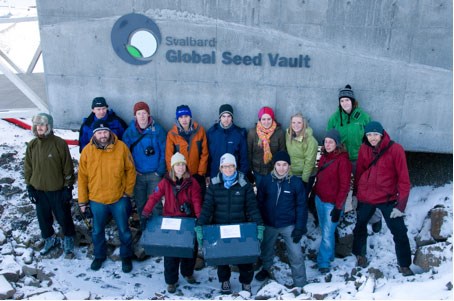Svalbard Global Seed Vault: New seeds in the vault
Historical archive
Published under: Stoltenberg's 2nd Government
Publisher: Ministry of Agriculture and Food
News story | Date: 16/10/2008 | Last updated: 04/03/2009
Svalbard Global Seed Vault: Early in October the content of the Svalbard Global Seed Vault grew by more than 30,000 new seed samples. The largest deposit this time was a shipment of 1.6 tons of seed samples from the gene bank of the international agricultural research institute ICRISAT in India. In addition, seeds were deposited from gene banks in Benin, Kenya and South Korea.
Svalbard Global Seed Vault: New seeds in the vault
Svalbard Global Seed Vault: Early in October the content of the Svalbard Global Seed Vault grew by more than 30,000 new seed samples. The largest deposit this time was a shipment of 1.6 tons of seed samples from the gene bank of the international agricultural research institute ICRISAT in India. In addition, seeds were deposited from gene banks in Benin, Kenya and South Korea.
The Nordic Genetic Resource Centre (NordGen), which is responsible for the coordination of shipments from the world's seed banks, organized the last stage of the seeds' long journey and ensured that the seeds were properly stored and registered.
Information on individual seed samples are available at the "Seed portal" – the seed vault's searchable online database
Arctic deposit
In addition to the tropical originating countries mentioned above, an important Arctic deposit was also made. With the support of the Svalbard Environmental Protection Fund, researcher Inger Alsos at UNIS has led a project to collect Svalbard's flora for preservation in the seed vault. In the report from the field work the following is stated: "We worked in teams of 4-6 people and collected seeds in the Isfjord region: Colesdalen, Bohemanflya, Kapp Thordsen, Sassendalen and Longyearbyen areas. The field work was uneventful with the exception of periodically poor weather conditions and extremely cold fingers."
In total the UNIS-group collected more than half a million seeds from 88 of a total of 165 known species of Svalbard's ferns and fern allies. Contrary to the food crop plants, we have little or no knowledge of the germination capacity of the Svalbard seeds. In order to ensure that the seeds stored actually are capable of germinating, the researchers will check the germination capacity after 9 and 18 months. Much indicates that the cold environment of the seed vault will suit the local seeds well, in fact the seeds of many Arctic species do not germinate until they have been kept cold for a period.

Photo: Frank Eggenfellner, UNIS
A saftey deposit
The Svalbard Global Seed Vault is primarily a safety deposit for duplicates of seed collections in gene banks that preserve crops and it will continue to be just that, however, an exception has been made for the preservation of Svalbard's flora. With rapid climate change in the polar areas as a backdrop, it is important to see what role the seed vault may play in preserving plants in its Arctic environment.
Svalbard Global Seed Vault: Early in October the deposits in the Svalbard Global Seed Vault increased by more than 30,000 new seed samples.
